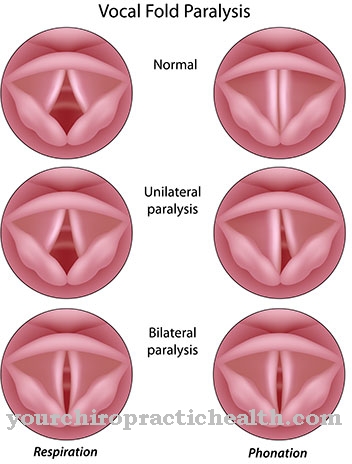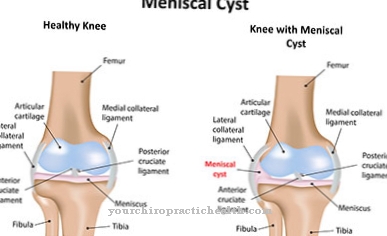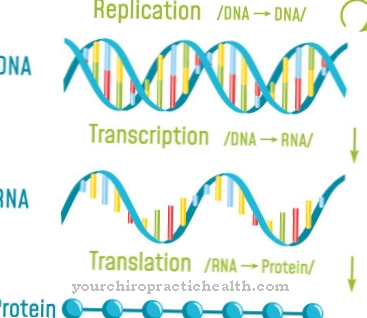In order to perform their function in the body, some cells have to move from one place to another. At this Cell migration They make use of the cell's own structures and at the same time are attracted by foreign substances. Misdirected cells contribute to the development and exacerbation of diseases such as cancer, multiple sclerosis and atherosclerosis.
What is cell migration?
The term "cell migration" describes the movement of a cell within the organism. Most of the cells are constantly in motion. Cell migration involves undirected and targeted migration, depending on what type of cell it is and what task it has to fulfill (building new tissue, defense against pathogens, etc.).
Purposeful movements are mostly made by triggers such as certain attractants. Many cell migrations are useful for the organism. Others, in turn, cause illnesses to develop or make existing illnesses worse. Sometimes one and the same molecule is even used for supporting and damaging cell migration.
In the Cell migration the cells move in different ways. In phase 1 of the movement, for example, the cell stretches out its extensions and hooks some of them into the substrate. This is how she determines the direction of her movement. In phase 2, the anchored appendages pull the cell in the specified direction and then detach again. The direction of cell migration is determined by the Golgi apparatus in each cell.
Thanks to modern laser microscopy and innovative protein labeling methods, cell migration can now be examined in detail.
Function & task
Cell migration has different goals. The germ line cells present in the embryo migrate to where the respective sex organ will later form. In the germline cells of the zebra-fish embryo, for example (in which the hitherto unknown cell migration has already been extensively researched), cell migration takes place with the help of the proteins that originally held the blastomeres together (E-cadherins), the transcription factor Oct4 and the epidermal growth factor EGF . The former blastomeres attach themselves to the neighboring cells with the sticky e-cadherins and pull themselves along them. Other cells migrate to their destination, where they combine with other cell types to form a cell association (organ).
Immune cells first drift aimlessly in the bloodstream and then pounce on pathogens in order to eliminate them: leukocytes use chemokine receptors such as Cxcr4b to detect dangerous pathogens. Chemokines are molecules that act as signposts during cell migration. Other leukocytes repair the inner wall of the vessel damaged by arteriosclerosis. They move with the bloodstream and attach to the cells in the vessel wall. Then they scan the wall surface with their appendages. If they perceive the chemical signal of an inflamed cell, flatten themselves and try to cross the border between the cells of the vessel wall. It is assumed that they imitate the chemical signal of the inflamed cell, which serves as a key.
Symptoms, ailments & signs
Cell migration in the organism is a normal process that usually goes unnoticed. On the contrary, the lack of cell migration of certain cells would jeopardize the viability of the organism. Immune cells, for example, have to constantly migrate through the organism in order to protect it from pathogens.
However, as part of the fight against infection, they cause inflammation at the site of the infection. The tissue heats up there. If the pathogens are already spread in the body, the body temperature increases. Here, the cell migration of the immune cells is a normal consequence of the infection, which then creates the typical signs of disease due to the struggle of the escaped immune cells with the pathogens.
Immune cells can also be misdirected and attack the body's own tissue and thus cause a wide variety of complaints. It is then autoimmune diseases. Among other things, multiple sclerosis is an autoimmune disease. Here the insulating layer of nerve cells is destroyed. The patient suffers from paralysis, impaired vision and impaired skin sensitivity.
In addition, there are premature exhaustion, concentration disorders, memory problems, depression and much more. Atherosclerosis is also caused by incorrect cell migration. In this way, the immune cells migrate to the cholesterol that is stuck to the vessel walls and try to break it down. During this experiment, they turn into so-called foam cells, which, as plaques, can clog the blood vessels. Finally, one of the negative aspects of cell migration is the spread of cancer cells in the organism. This creates metastases in other organs, which make curative cancer treatment difficult or even impossible.
You can find your medication here
➔ Medicines for paresthesia and circulatory disordersIllnesses & ailments
If cells do not migrate in the body as they should, diseases develop. Enzymes such as matrix metalloproteases (MMP) make vascular walls and tissue so full of holes that misdirected cells can pass through them. The factor SDF-1, which is responsible for the migration of zebrafish germline cells, is also used for harmful "work" in the body: It is also involved in the formation of cancer metastases, the development of arthritis and the spread of HIV infection in the body.
Inside the metastatic cells of some types of cancer there are MAPKs, proteins that trigger cell migration, initiate cell division and are even responsible for cell degeneration. The MAP kinases are held in the cell nucleus by a protein called STYX (pseudophosphatase). If the enzyme is destroyed, the Golgi apparatus of the cell also breaks up, so that the cell is no longer capable of targeted migration. Since there is a greatly increased proportion of the STYX protein in breast cancer patients, for example, science assumes that an effective cancer drug would have to be designed to switch off the STYX in order to prevent the cancer from metastasizing.
The epidermal growth factor EGF apparently also plays a decisive role in the migration of cancer cells. If its receptor is destroyed by a mutation, EGF is permanently active: It stimulates the cancer cells to migrate permanently. Skin cancer cells have developed a special way of carrying out cell migration. They simply turn vesicles outwards, restructuring their flexible cell skeleton.
In multiple sclerosis, immune cells are reprogrammed so that they not only attack harmful pathogens, but also healthy cells. The pathogens form structures on their cell surface that are similar to those of the body's own cells and thus attract the immune cells. If these then eat them, the immune cells imprint the molecular structure and then attack the body's own healthy cells.
The transformed immune cells move through the body even more aggressively because they now have even more molecules with which to move through tissue. They can even cross the blood-brain barrier, which is insurmountable for most substances. In the brain, they attack healthy tissue and thus trigger the flare-ups feared by MS patients: They deactivate the cells that build up the protective myelin layer around the nerve cells. This weakens the nerve cells lastingly and disrupts the transmission of information.
Complications
Cell migration is a natural process that occurs naturally in the body and normally does not cause complications. However, if the cells in the body do not migrate as intended, diseases can occur. Depending on where in the body a misdirection of the cells occurs, this can lead to harmless temporary symptoms, but also to serious diseases such as cancer or multiple sclerosis.
Misdirected cells are favored by enzymes such as matrix metalloproteases. These damage the vessel walls and tissue and thus enable the cells to be misdirected to other regions of the body. Other enzymes and substances can also cause cell migration and thus promote diseases such as arthritis and cancer. The spread of HI viruses in the body is also promoted by misdirected cells.
There is also an increased risk of multiple sclerosis, nerve damage and countless other diseases and symptoms, each of which is associated with serious complications. The cell migration itself is not a problem, but the processes that are set in motion have serious health consequences. A treatment of cell migration is not possible, as this takes place within the smallest molecules and the misdirection takes place randomly.
When should you go to the doctor?
In many cases, cell migration is only noticed late by the person concerned. Often there are diffuse health irregularities that cannot initially be explained. A check-up visit to a doctor should therefore always be made at regular intervals. The general state of health is recorded and compared with the normal values. In the event of anomalies, it is possible to react immediately. In addition, a doctor's visit is necessary if there are disturbances in concentration or attention, behavioral problems or a general malaise. If the person concerned suffers from a depressed mood and the daily obligations can no longer be fulfilled as usual, there is a need for action.
Consult a doctor as soon as possible in the event of impaired vision or mobility. Medical care is also necessary in the case of paralysis and disorders of sensitivity. If swelling is noticed on the body, if there are changes in the complexion of the skin or if participation in social life decreases, these complaints should be discussed with a doctor. If irregularities such as headache or fever appear, the affected person needs medical treatment. If premature exhaustion occurs repeatedly during the day despite a restful night's sleep, this process should be viewed as an indication of a health disorder. Examinations are necessary to enable a diagnosis to be made.
Aftercare
Follow-up care for a misdirected cell migration depends on the cause. For cancer or multiple sclerosis, follow-up care takes place as soon as the condition has been cured. It can include follow-up medical examinations, discussions with therapists or further specialist visits. As part of follow-up care, the trigger for the misdirected cells will be eliminated, insofar as this is possible.
In the case of cancer, for example, a change in lifestyle is necessary. This can prevent the cells from being misdirected again. Follow-up care is carried out by the responsible specialist. Which doctor is responsible also depends on the underlying disease. If necessary, several physicians are involved, for example to guide a final physiotherapy or to control the drug treatment.
Depending on the cause, nutritionists or sports medicine specialists can also be part of the aftercare. Patients should have regular medical examinations following treatment. From a certain age, the routine examinations for cancer screening are covered by the health insurance company.
It is important to discuss the options for aftercare with the family doctor and to initiate the necessary steps together with a specialist. Depending on the disease, aftercare for a misdirected cell migration can be a long-term process that has to be adapted again and again.
You can do that yourself
The process of cell migration is a natural process that cannot be consciously perceived and controlled. For this reason, the possibilities for self-help in the event of malfunctions and irregularities of any kind are limited.
Overall, the person concerned can ensure compliance with a healthy lifestyle and should immediately seek cooperation with a doctor in the event of existing health problems or functional limitations. If there is swelling or other abnormalities, check-ups are necessary. As a preventive measure, preventive health measures can be initiated at regular intervals. In every age group there is the possibility of having the general health checked by the family doctor. This offer should be used over the entire lifespan.
If the general susceptibility to infection increases, greater attention is required. With a healthy lifestyle, a balanced diet, sufficient exercise and a body weight in the normal range of the BMI, it is considered worrying if inflammations or infections occur more frequently. A sustained, slightly increased body temperature is also to be interpreted as a warning signal from the organism.
To avoid malfunctions that occur, work should, for example, be carried out under optimal lighting conditions and the organism should be protected from general stress conditions. A balanced sleep prevents disturbances in concentration or memory. Emotional and physical stressors must also be reduced to a minimum.












.jpg)



.jpg)










.jpg)
